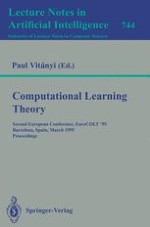This volume presents the proceedings of the Second European Conference on Computational Learning Theory (EuroCOLT '95), held in Barcelona, Spain in March 1995.
The book contains full versions of the 28 papers accepted for presentation at the conference as well as three invited papers. All relevant topics in fundamental studies of computational aspects of artificial and natural learning systems and machine learning are covered; in particular artificial and biological neural networks, genetic and evolutionary algorithms, robotics, pattern recognition, inductive logic programming, decision theory, Bayesian/MDL estimation, statistical physics, and cryptography are addressed.
